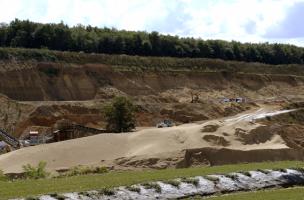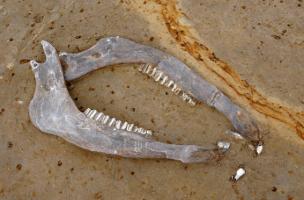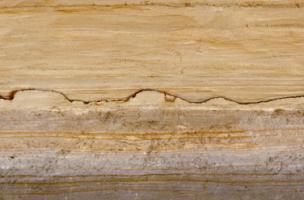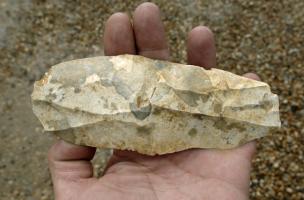You are here
When Neanderthal man stopped at Tourville-la-Rivière
A team of a archaeologists from Inrap (The National Institute for Preventive Archaeological Research) is at present excavating, curated by the State (Regional Archaeological Service - DRAC - Haute-Normandie), a prehistoric and paleontological site over 200,000 years old at Tourville-la-Rivière, Seine Maritime.
Situated on one of the numerous bends of the meandering river Seine, at 14 km south of Rouen, the site is situated in a sand and gravel quarry exploited by the CBN company (Carrières et Ballastières de Normandie). This extensive excavation continues a long tradition of paleontological and pre-historical research carried out during the 19th and the first half of the 20th centuries in quarries in the north of France (by Jacques Boucher-de-Perthes, the Abbé Breuil, François Bordes …).
On the banks of the Seine

The excavation is focused on alluvium layers rich in remains and characteristic of the end of an interglacial period, about 200,000 years ago.
In these layers, 1.50 to 2 metres thick, excavated over a surface of one hectare, pre-historians have brought to light remains of fauna and worked silex. These stone tools, over 200 000 years old, correspond to the Early Mousterian epoch whose craftsman is situated in the human Neanderthal lineage: they were pre-Neanderthals, or early Neanderthals (to be linked with the human fossils of Biache-Saint-Vaast in the Pas de Calais or La Chaise in Charente).
Temperate climate fauna
This accumulation results, for a large part, from natural phenomena: animal carcasses, whole or part, all species mixed, carried by the Seine, were deposited on the banks or on the sandbanks at the foot of a chalk cliff.
Archaeologists know that the remains of fauna were rapidly covered by alluvium. This process is notably perceptible through the good preservation of the antlers, particularly vulnerable when exposed to the open air for long periods.
Particularly sophisticated tools, remarkably effective
The flint-knapping industry seems to reply quite efficiently to immediate and specific needs. Levallois flakes and blades, particularly elaborate technically and remarkably efficient functionally, are instruments all designed for the cutting up of animal matter (flesh, tendons, hide …) of fauna naturally deposited on the banks of the Seine.
Without questioning their formidable talents as hunters and without using the term ‘carcassing’ (which should be limited to the animal sphere), it is clear that the pre-Neanderthal populations adopted behaviour of subsistence implying the development of an adequate economic technical strategy.
At Tourville-la-Rivière, the pre-Neanderthals seem to have occupied the sites in the context of stopovers of short duration. The site does not thus correspond to a durable settlement of these populations. The small quantity of flint tools, or even the feeble extension of the production zones, denotes the transient nature of the human occupations.
Subsistence activities complementary to hunting





Mahaut Tyrrell
Media communication
Inrap, media partnerships and relations department
01 40 08 80 24
mahaut.tyrrell [at] inrap.fr
Mélanie Scellier
chargée du développement culturel et de la communication
Inrap, direction interrégionale Grand Ouest
02 23 36 00 64
melanie.scellier [at] inrap.fr



